Twister Movie Put NSSL on the Map
By Rachel Shortt
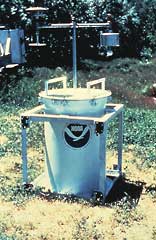
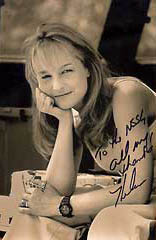
Did you know the movie "Twister," from producers Steven Spielberg and Kathleen Kennedy and director Jan de Bont was written about the National Severe Storms Laboratory right here in Norman, Okla.?
Michael Crichton and his wife, Anne-Marie Martin, wrote a screenplay about the lab's activity with the University of Oklahoma in the early 1980's on TOTO, a 55 gallon drum researchers attempted to place in the path of a tornado to collect measurements. Their screenplay turned into the movie "Twister" starring Bill Paxton and Helen Hunt, and NSSL staff had an opportunity to provide input to the script, production and even the direction the movie took.
Kevin Kelleher, NSSL Deputy Director, remembers a phone call in February 1995 from a man asking if the lab would help in a project he was referring to as a "feature film." Unsure of what that was, Kevin invited him and his crew to come to the facilities for a tour.
"I said, now this isn't where I go to the movies and I see it at my local Hollywood Theatre, is it?" asked Kelleher. "And the man said, 'Yes, that's exactly what it is' -- and then I began to realize this was a big deal."
The producers, Spielberg and Kennedy, partners since the mid 1970's, had worked on several projects together, including "E.T." They had always wanted to produce a film about tornadoes, somewhat in the spirit of "The Wizard of Oz," but they never had the technology to produce tornadoes on-screen. With the development of digital technology, the movie could actually start to take shape.
NSSL made several positive contributions to the production of the film. The script included a tornado that would form and last for almost a day and a half. Kelleher brought a map out in his office and showed the filmmakers how this could never happen, but that it was possible for an "outbreak" of tornadoes, which allowed for the scenario in the movie of a tornado at any place at any time, in any location, and of different magnitudes.
Harold Brooks, NSSL research meteorologist, also looked at the script and made comments on what the actors were saying, if it was realistic or not. Most of the time, the filmmakers would change things. Brooks also interacted with the producers to help them figure out where they needed to go and what kinds of training they needed for things such as lightning safety when they were out filming. He also helped create believable backgrounds for some of the scenes in the movie.
Several actors, especially Bill Paxton, spent a lot of time at NSSL to get a feel for the coordination the Lab undergoes to be successful in tornado experiments, such as VORTEX '95, which took place while the actors were visiting. Many of the actors had the opportunity to go out on a tornado chase that led them all the way into Texas.
"There were tornadoes out that day, but we missed them all," said Kelleher. "We were always a few minutes late."
Kelleher felt the actors were truly impressed and sincerely appreciated what the NSSL really does after this experience.
"They appreciated not only the danger involved, but the value of the research we do," he said.
There were many positive impacts "Twister" had on the NSSL.
"Sure it wasn't a documentary, it was a Hollywood movie, so if you take it in that context, it put us on the map," said Kelleher. "After the movie, everyone knew where Norman was, and the National Severe Storms Lab and the University of Oklahoma."
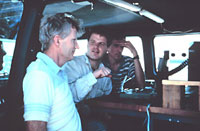 |
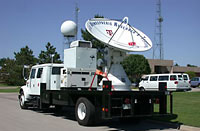 |
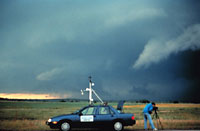 |
In fact, due largely in part to the movie, enrollment increased at OU's School of Meteorology for both graduate and undergraduate students so much that it became one of the largest programs in the country. The movie also built a relationship between NSSL and Universal Studios, allowing NSSL to add severe weather safety tips to the "Twister" attraction in Orlando. This led to a grant from Universal Studios to OU, which allowed development of a mobile radar.
The movie has many unrealistic parts, Kelleher believes, such as the ending when the actors strap themselves to a pipe in the middle of an F5 tornado and come out virtually unscathed.
"I think that gave the impression tornadoes aren't as dangerous and destructive as they are," said Kelleher. "I remember Bill Paxton came up to me after they filmed that part and said, 'You know, you are just not going to like the ending, it's not going to be the best, but the rest of the movie should be pretty good.'"
All in all, both Kelleher and Brooks believe the impact of the interaction between NSSL and the moviemakers was positive.
"It's actually increased understanding of tornadoes around the world," said Brooks. "When the movie came out in Finland, for example, people over there started saying, 'Oh yeah, I've seen things like this before.'"
NSSL has made several international contacts indirectly from the movie, Brooks added, which has helped NSSL work more closely with other world meteorological institutes.